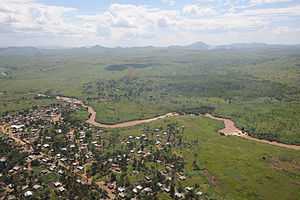Bunia
| Bunia | |
|---|---|
 | |
 Bunia | |
| Coordinates: 1°34′N 30°15′E / 1.567°N 30.250°E | |
| Country |
|
| Province | Orientale |
| District | Ituri Interim Administration |
| Government | |
| • Mayor | Marie Louise Uronya Fwanuti |
| Area | |
| • Total | 57.6 km2 (22.2 sq mi) |
| Elevation | 1,277 m (4,190 ft) |
| Population (2012) | |
| • Total | 366,126 |
| • Density | 6,400/km2 (16,000/sq mi) |
Bunia is a city in Democratic Republic of the Congo (DRC) and is the headquarters of Ituri Interim Administration in the Ituri region of Orientale Province. [1]
It lies at an elevation of 1275 m on a plateau about 30 km west of Lake Albert in the Albertine Rift, and about 25 km east of the Ituri Forest.
The city is at the center of the Ituri conflict between the Lendu and Hema. In the Second Congo War the city and district were the scene of much fighting and many civilian deaths from this conflict, and related clashes between militias and Uganda-based forces. Consequently the city is the base of one of the largest United Nations peace-keeping forces in Africa, and its headquarters in northeastern DRC. The area's natural resources include gold mines over which militias and foreign forces have been fighting.
Climate
| Climate data for Bunia | |||||||||||||
|---|---|---|---|---|---|---|---|---|---|---|---|---|---|
| Month | Jan | Feb | Mar | Apr | May | Jun | Jul | Aug | Sep | Oct | Nov | Dec | Year |
| Average high °C (°F) | 29 (85) |
29 (84) |
29 (84) |
28 (83) |
27 (81) |
26 (79) |
26 (78) |
26 (79) |
27 (81) |
27 (81) |
27 (81) |
28 (83) |
27.4 (81.6) |
| Average low °C (°F) | 16 (61) |
17 (62) |
17 (62) |
17 (63) |
17 (63) |
16 (60) |
16 (60) |
15 (59) |
15 (59) |
16 (60) |
15 (59) |
16 (60) |
16.1 (60.7) |
| Precipitation mm (inches) | 140 (5.5) |
173 (6.8) |
239 (9.4) |
269 (10.6) |
318 (12.5) |
267 (10.5) |
310 (12.2) |
394 (15.5) |
244 (9.6) |
274 (10.8) |
300 (12) |
165 (6.5) |
3,093 (121.9) |
| Source: Weatherbase [2] | |||||||||||||
Transport
The main dirt highways connecting north-eastern DR Congo with Kisangani to the west and Butembo and Goma to the south pass through Bunia, but have fallen into disrepair and are virtually impassable, especially after the frequent rains.
Bunia is only 40 km from the Ugandan border running down Lake Albert, but there are no road connections across the Great Rift Valley to the closest Ugandan towns of Toro and Fort Portal. Instead a dirt highway going north-east reaches Arua and Gulu north of the lake. Before the war made the route impassable, this was the chief trade route between the DRC and Uganda, as well between the DRC and Juba in South Sudan, and Bunia was an important market city, for cross-border trade as well as internal trade.
The supposed route of the Lagos-Mombasa Highway passes just to the south of Bunia, emphasising its potential as a centre of trade, but that transnational highway does not exist as a viable route through the DRC.
Bunia is linked to the small port of Kasenyi on Lake Albert by a 60-kilometre dirt track via Bogoro, which has a spectacular and dangerous 600-metre descent of the western escarpment of the Great Rift Valley. Kasenyi has a 100 m jetty from which boat transport can link with Mahagi-Port at the north end of the lake, and with Butiaba on the Ugandan side and Pakwach on the Albert Nile.
Given the poor state of the roads, and the total lack of railway transport, Bunia Airport is of prime importance.
Other features in the locality

Mount Hoyo is 35 km south-west of Bunia. The Shari River flows along the north-western outskirts of the city. The Ituri River flows around 35 km west of Bunia. The confluence of the Shari and Ituri is about 45 km south-southwest of Bunia.[3]
Although Bunia is about 170 km north of the Equator, the city was featured in the BBC television travel documentary Equator made in 2006, since it was one of the few places near the Equator in eastern DRC where the safety of the TV crew could be assured, by the presence of the large UN peace-keeping force.
Higher Education
Bunia has a number of Universities, the largest being the University of Bunia (UNIBU) followed by the private Université Shalom de Bunia (USB) which offers the largest library in Bunia (about 40.000 volumes) with an online catalog system.
References
- ↑ "Congo (Dem. Rep.): largest cities and towns and statistics of their population". World Gazetteer. Retrieved January 21, 2009.
- ↑ "Weatherbase: Historical Weather for Bunia, Democratic Republic of the Congo". Weatherbase. 2011. Retrieved on November 24, 2011.
- ↑ Google Earth —measurements and directions checked.
External links
- Detailed Map of Bunia
- Map of tribal areas of Ituri
- Congo's battle with disarmament, BBC, 9 June 2005
- Watch Equator, the BBC TV program featuring Bunia
| |||||||||||
Coordinates: 1°34′N 30°15′E / 1.567°N 30.250°E